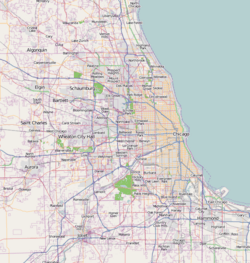Hyde Park–Kenwood Historic District facts for kids
|
Hyde Park–Kenwood Historic District
|
|

Rough boundaries of the district
|
|
| Location | Roughly bounded by 47th and 59th Sts., Cottage Groves and Lake Park Aves., Chicago, Illinois |
|---|---|
| Area | 745 acres (301.5 ha) |
| Built | 1885 |
| Architect | Multiple |
| Architectural style | Late 19th And 20th Century Revivals, Prairie School, Late Victorian |
| NRHP reference No. | 79000824 |
|
Hyde Park–Kenwood Historic District (Boundary Increase I and II)
|
|
| Location | 821–829 and 816–826 E. 49th St., Chicago, Illinois (increase 1) 825–833 and 837–849 E. Fifty-second St., Chicago, Illinois (increase 2) |
| Area | 1 acre (0.4 ha) |
| Built | 1916, 1924 |
| Architectural style | Mission/Spanish Revival, Other, Courtyard Apartments |
| NRHP reference No. | 79000824 (original) 84000996 (increase 1) 86001041 (increase 2) |
Quick facts for kids Significant dates |
|
| Added to NRHP | February 14, 1979 |
| Boundary increases | August 16, 1984 May 16, 1986 |
| Added to NRHP | February 14, 1979 |
The Hyde Park–Kenwood Historic District is a special area on the South Side of Chicago, Illinois. It's listed on the National Register of Historic Places (NRHP). This means it's recognized for its important history and unique buildings.
The district includes parts of the Hyde Park and Kenwood neighborhoods. It's mostly a residential area, meaning many people live there. Even though the University of Chicago owns a lot of land nearby, the district itself is mainly homes.
This historic district is important for two main reasons: its amazing architecture and its connection to education. It was first added to the NRHP on February 14, 1979. Later, it was made even bigger on August 16, 1984, and again on May 16, 1986.
Contents
What Makes the Hyde Park–Kenwood District Special?
The Hyde Park–Kenwood Historic District is known for its beautiful and historic buildings. It shows off many different styles of architecture from the late 1800s and early 1900s.
Where is the Hyde Park–Kenwood Historic District Located?
The district has clear boundaries. To the north, it's 47th Street. To the south, it's 59th Street. Lake Park Avenue is on the east side, and Cottage Grove Avenue is on the west.
Who Lived in This Historic Chicago Area?
A very famous person, Barack Obama, had his Chicago home in the northern part of this district. He lived there before and during his time as President of the United States. This part of the district also overlaps with the Chicago Landmark Kenwood District.
Discovering Historic Buildings in Hyde Park–Kenwood
Many individual buildings within the Hyde Park–Kenwood Historic District are also listed on the National Register of Historic Places. These buildings are called "contributing properties" because they help make the district special.
Famous Homes and University Buildings
Some of the notable buildings in the district include:
- Frank R. Lillie House
- Isidore H. Heller House
- Amos Jerome Snell Hall and Charles Hitchcock Hall (part of the University of Chicago)
- Arthur H. Compton House
- St. Thomas Church and Convent
- Frederick C. Robie House (a famous example of Prairie School architecture)
- George Herbert Jones Laboratory (another University of Chicago building)
- Robert A. Millikan House
- University Apartments
Historic Milestones in the District
Two very important sites within the Hyde Park–Kenwood Historic District were among the first places ever listed on the National Register of Historic Places back on October 15, 1966. These are:
- Chicago Pile-1: This was the world's first artificial nuclear reactor, a huge scientific achievement.
- Frederick C. Robie House: A masterpiece designed by the famous architect Frank Lloyd Wright.
These buildings and the district itself help us understand Chicago's rich history and amazing architecture.


